 What happens when visitors to two of literature’s most famous fairylands cross paths? And what happens when visitors from those other worlds start crossing over into our own? Writer Ben Avery (from our fellow Christian geek podcast and blog, Strangers and Aliens) and artist Casey Heying tell the tales in The Oz/Wonderland Chronicles (from Buy Me Toys; collected in trade paperbacks, 2011-2012), an ambitious, intricately plotted, lushly illustrated fantasy epic.
What happens when visitors to two of literature’s most famous fairylands cross paths? And what happens when visitors from those other worlds start crossing over into our own? Writer Ben Avery (from our fellow Christian geek podcast and blog, Strangers and Aliens) and artist Casey Heying tell the tales in The Oz/Wonderland Chronicles (from Buy Me Toys; collected in trade paperbacks, 2011-2012), an ambitious, intricately plotted, lushly illustrated fantasy epic.
Both Daniel and Mike had been intrigued, separately, by the project. Together, they offer SFC readers their take on the meeting of marvelous places and people that Avery and Heying have created.
Do you feel these stories represent Oz and Wonderland well?
Dan: I honestly have not read any of the Oz books, though I have read both Alice in Wonderland and Through the Looking Glass. I have seen numerous depictions of both fantasy lands, from the classic MGM Wizard of Oz to Disney’s animated Alice in Wonderland. In many ways, Avery and Heying provide a more coherent Wonderland than Carroll’s originals; his books are such a chaotic jumble that an author has a lot of freedom when repackaging and extended the basic source content. With Oz, I really only have the MGM movie to base any strong opinions on. I applaud the authors for not just using the characters that everyone knows, but using this series as an opportunity to introduce us to unfamiliar Oz characters like Hungry Tiger and Jack Pumpkinhead. If anything, the authors introduced me to the world of Oz beyond Judy Garland.
Mike: Well, as long as we’re confessing… I’ve never read any Lewis Carroll! My only knowledge of Wonderland comes from seeing bits and pieces of Disney’s animated Alice. I do now feel motivated to read the originals, having read Avery and Heying’s take on them. But I can attest that these creators’ Oz credentials are impeccable. They weave all the major literary denizens of Oz into their tale, plus quite a few minor ones. Only a reader of Baum’s books would think to include the Kalidahs, for example, or to summon the big blue dragon Quox. Avery and Heying also manage to sneak in subtle allusions to the MGM movie (for instance, I loved the Scarecrow’s mangled recitation of “E pluribus unum” as he is being re-stuffed with his brains!). After my disappointment with Disney’s new Oz movie, I was ready for a really good Oz story. Oz/Wonderland definitely delivers!
Do these stories conform to canon?
Mike: While I can’t speak to Wonderland’s continuity (or even if such a concept applies in the world of the Mad Hatter), Baum himself didn’t overly worry about “canon” in Oz, so Avery and Heying are in good company with their selective approach to the backstory of Oz. They are certainly more careful than many Oz authors and artists have been. The text pages involving Cap’n Bill and Dorothy, for example, mimic the look of a chapter from the actual Oz books, right down to the headpiece (though Heying’s line drawings are far more subtle than anything John R. Neill provided). Avery’s script sticks to the basic, overarching plot of Baum’s Oz tales—Princess Ozma assumed her rightful place on Oz’s throne; the Wizard returned, as did Dorothy, who eventually brought Aunt Em and Uncle Henry with her; and select other folk from our world continued to cross over—but then deviates from Baum by establishing a kind of mass exodus from the fairyland, beginning with the Wizard. It’s a necessary change, not only dramatically, but also thematically—but I know we’re going to talk about that in a bit.
Dan: There have been so many versions of these stories that I question if I even know what canon is anymore. I do believe that Avery and Heying have researched the original stories, various adaptations of them (such as the MGM film), understand which elements are available to for them to use and which ones are legally barred from their world, and have introduced characters like Hungry Tiger that come from the source material but have not been in the public eye. I could easily see The Oz/Wonderland Chronicles as a sequel to the Judy Garland movie since we have all of the key characters from that film extended into the future.
I also appreciate that they have gone beyond Oz and Wonderland. The roommates are examples of characters mined from other literature, even if they cannot be called by their familiar names. Even Mae Mannering, the main character from volume 2, has a rich literary origin. Sadly, it took a conversation with Ben Avery to make her origin clear to me!
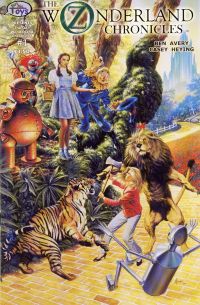 Mike: Interesting. I saw the blurb on the cover of the first trade—“Movie studios take note”—and I’d buy my ticket right now if such an adaptation were announced! Do you think it would also serve a mass audience well as a sequel to either of Disney’s Alice efforts?
Mike: Interesting. I saw the blurb on the cover of the first trade—“Movie studios take note”—and I’d buy my ticket right now if such an adaptation were announced! Do you think it would also serve a mass audience well as a sequel to either of Disney’s Alice efforts?
Dan: I don’t think Disney would frame it as a sequel to the animated Alice in Wonderland, but I can see how elements could be incorporated into a program like Once Upon a Time. Or (cough, cough) maybe other studios could look to these tales as an alternative to Snow White’s adventures in Storybrooke.
What did you like the most?
Mike: I liked so much, it’s hard to choose just one aspect! Frankly, as much as I enjoyed both collected volumes, I was surprised at how much I enjoyed seeing Jack Pumpkinhead and Scraps the Patchwork Girl cross over into our world. This development appealed to me in part because Heying does a first-rate job of bringing these iconic Ozites to life (I’d swear I saw Scraps move before my eyes, right there on the printed page), but also because the concept is so wonderful: Jack wants to discover why everyone who comes to Oz from Earth eventually wants to go back, and is convinced that Earth, not Oz, is the “land of wonder.” It’s a delightful inversion, and the creators pull it off magnificently.
Dan: I really enjoy the fact that Alice and the roommates are X-Men fans (confirmed with Ben Avery). And, going beyond the X-Men, I really did enjoy Jack Pumpkinhead and the Cheshire Cat exploring our world in volume 2. I love that Jack and I are both fans of James Bond and Star Wars. Unsolicited story pitch: I would love to see Jack channel Bond in Oz! Patchwork Girl could be his Bond girl!
Mike: Agent Pumpkinhead, Licensed to Spoil.
Dan: I like the Wizard. Where is the merchandise so I can buy his baseball cap? This Wizard to me is an action hero with guns blazing. And honestly it is an interpretation of the Wizard that I would have never considered.
Mike: Yeah, me neither, and that’s one thing I’d take exception to—but, again, getting ahead of myself!
Dan: Krutack! (Does that ever get old?) After the dismal version of the Wizard that we saw in Oz the Great and Powerful I really enjoy this man of action who takes that con man’s place.
Mike: For what it’s worth, Oz redeems himself pretty quickly in the Baum books—and (if The Marvelous Land of Oz, the second book in the series, is taken as the “official” backstory) from a lot worse than just being a con man.
Dan: Wait your turn, Poteet! I also have to say, I liked the Wheelers. Their visual presentation was really well done because it seriously creeped me out as I read through the volume. I do not like scary, and they really scared me. I cannot think of anything else from a comic that gave me the creeps like the Wheelers did. So please no one come at me with wheels as hands. I will probably run away. And my scream may be high pitched!
What did you like the least?
Dan: I occasionally found the art distracting and confusing in volume 1. For example, at times I had difficulty distinguishing the roommates. They all looked very similar to me. Additionally, in one sequence with multiple frames on the page, Alice changes in my eyes from a blonde to a brunette who looks somewhat like her roommates or Dorothy, To be fair, in volume 2 I thought the roommates were more distinct. And as I write this I am reading a DC title in which an African-American character has turned Caucasian for a two-page spread.
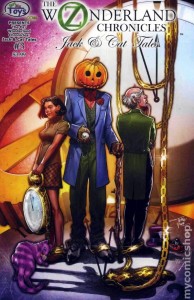 Volume 1 left me wanting to know more about the roomates’ true origins. The bios at the back dropped some clues, and, in volume 2, we get even stronger hints from Avery and Heying that there is more to thse young ladies than meets the eye. Is Suzie really Susan from Narnia?
Volume 1 left me wanting to know more about the roomates’ true origins. The bios at the back dropped some clues, and, in volume 2, we get even stronger hints from Avery and Heying that there is more to thse young ladies than meets the eye. Is Suzie really Susan from Narnia?
Mike: Yes.
Dan: Well, you don’t know that for a fact, do you?
Mike: I suspect legal issues prevented them from spilling the beans on Suzie. I can’t imagine she was intended as anyone else.
Dan: I am just saying that perhaps there is still more to come.
Mike: I hate to say it, but my major dislike was the art, as well. As you said, it is often quite inconsistent. I intensely dislike the way Heying draws Dorothy as a child—she is not supposed to be some spectacularly beautiful child in Baum’s books, but Heying has drawn her as really quite ugly.
Dan: Ouch!
Mike: Well, maybe this was a deliberate thematic choice, given the revelation at the end of the first volume, but I found most of the art featuring Dorothy quite unappealing. I also felt a little put off by the occasional “cheesecake” quality of adult Dorothy and Alice (although this quality showed up more in the pin-ups and variant covers by guest artists). Don’t get me wrong, it’s no Lost Girls—it’s quite mild, and it even plays into a subplot in the second volume.
Do you see spiritual applications in this story?
Dan: Wow! Where to begin? I found tons of spiritual applications, intentional or unintentional, in this title (unlike, say, Guardians of the Galaxy #1, which was somewhat of a spiritual wasteland). Perhaps the real difference here is we are reviewing two full arcs instead of one issue; the authors have room to setup and tell their complete story.
A really evident theme to me is sacrifice, which numerous characters do. For example, Glinda the Good Witch is never seen as the traditional happy, pretty blonde lady in a glittery dress. You will find that she has been transformed into a very different form, inconveniencing and sacrificing herself in order to provide protection to her friends. Jack Pumpkinhead sacrifices a symbol of his sentience to another character since this symbol was a luxury for himself but essential to the other. And, for me, the most striking example was the Wizard. I mentioned earlier this Wizard was an action hero. And a hero he is, putting himself into the midst of dangerous situations where a likely outcome would be his own death. This is a stark contrast to the recent Disney Wizard. That Wizard, at the moment of truth, is away from the most pressing action. He allows others to physically stand against the evil threatening the land of Oz. This Wizard puts himself into a position of physical danger where he could easily, and perhaps does, offer the ultimate sacrifice. And as we see more of the Wizard’s story in volume 2, we really come to see how much he has given up for those he cares about. These are just a few characters who put it all on the line for another.
Of course, as Christians we are familiar with this story, the story of one who took the burden of our problems (or sins) and paid the cost (died) in our place. Sacrifice is a theme that should resonate with us as it is one we have a history with, a history in which sacrifice freed us to walk tall despite the fact we do not deserve that right. As 2 Corinthians 5:21 states, “For our sake he made him to be sin who knew no sin, so that in him we might become the righteousness of God” (ESV). That is a big gift, a gift we did not deserve, and one we should not be shocked to find throughout literature, including graphic novels.
Mike: Your comments reminded me of one “dislike” I had with the story. I agree that Avery and Heying’s Wizard is infinitely preferable to James Franco’s, but I do not see Baum’s Oscar Diggs as someone who would come in, guns a-blazing, not even to save another. I may be forgetting some example of the Wizard’s gunplay from the texts, but, as I recall, Baum’s Wizard was a smart man who always sought a smart solution out of his various scrapes. In the first book, he used his intelligence to be a humbug; but in later volumes, he was equally as smart, only now he used his wits to help, rather than deceive. He becomes one of Glinda and Ozma’s most trusted associates and friends. In Oz/Wonderland, however, most of the time we see the Wizard, he is shooting off round after round of ammunition. I objected to this characterization, and for that reason found it appropriate that his upswept locks of hair (original to Neill’s illustrations) grew more and more to look like devil’s horns.
Dan: Still, Mike, you’d agree that sacrifice is a major spiritual theme in Oz/Wonderland?
Mike: Absolutely. I’m not saying it’s a major flaw with the work (and, since the Wizard’s gunplay is all directed at malevolent fantasy creatures, that’s probably mitigating circumstance enough), but I think it bears some closer reflection than it gets in these pages.
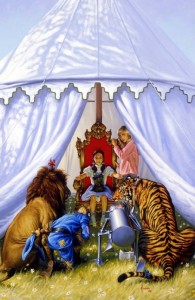 Dan: Another spiritual lesson is that there are some battles that cannot be won but they must not be lost. I think as the church we often feel this tension. As we look at issues like famine, poverty, and the environmental pollution, we probably feel like we cannot win these battles. But even if we alone cannot beat these problems, as a church we cannot lose these battles and we must battle on. We must also remember that we do not fight these battles alone. First, we fight them as the united church so we fight as group not individuals, strengthening our power in these battles. Second, as ambassadors of God we battle with the Father’s power and authority. Yes, we may feel like we cannot win, but we also cannot lose. We must remember, brothers and sisters, that we are instruments in the reclamation of this Earth, and our victory is already ensured. As confusing as Revelation can be at times, I often find strength in this verse, “Then I saw ‘a new heaven and a new earth,’ for the first heaven and the first earth had passed away, and there was no longer any sea” (Rev. 21:1). We may feel like we are losing, but the scoreboard already shows our victory.
Dan: Another spiritual lesson is that there are some battles that cannot be won but they must not be lost. I think as the church we often feel this tension. As we look at issues like famine, poverty, and the environmental pollution, we probably feel like we cannot win these battles. But even if we alone cannot beat these problems, as a church we cannot lose these battles and we must battle on. We must also remember that we do not fight these battles alone. First, we fight them as the united church so we fight as group not individuals, strengthening our power in these battles. Second, as ambassadors of God we battle with the Father’s power and authority. Yes, we may feel like we cannot win, but we also cannot lose. We must remember, brothers and sisters, that we are instruments in the reclamation of this Earth, and our victory is already ensured. As confusing as Revelation can be at times, I often find strength in this verse, “Then I saw ‘a new heaven and a new earth,’ for the first heaven and the first earth had passed away, and there was no longer any sea” (Rev. 21:1). We may feel like we are losing, but the scoreboard already shows our victory.
Mike: I like where you’re going with that, Dan, and I think Oz/Wonderland also addresses God’s victory over death. The crisis driving the first volume is Dorothy’s inability to accept and move beyond Uncle Henry’s death. Her grief assumes an incredibly complicated form! The Wicked Witch taunts young Dorothy for even entertaining Aunt Em’s quotation of Ecclesiastes, that for everything “there is a season, and a time for every matter under heaven,” including “a time to be born, and a time to die” (3:1-2, NRSV). But Aunt Em was right to turn to that Scripture for consolation, and Dorothy eventually learns that truth, too. I found it pretty powerful to be reading Oz/Wonderland in the Easter season, because Christians have not only the kind of stoic philosophy of Ecclesiastes to draw on when confronted with death, but also and more importantly the promise that we will share Jesus’ Resurrection: “For he must reign until he has put all enemies under his feet. The last enemy to be destroyed is death” (1 Cor. 15:25-26, NRSV).
Of course, the promise of eternal life doesn’t take away the pain we feel when our loved ones die. Dorothy wasn’t wrong to grieve Uncle Henry. But she was wrong to grieve as one without hope (see 1 Thess. 4:13). Christian faith offers a remarkable hope—and “a sure and certain hope,” as so many funeral rites put it—in the face of death.
I love what the Heidelberg Catechism, a sixteenth-century Reformed statement of faith, has to say about the hope the risen Christ gives:
Even as I already now experience in my heart the beginning of eternal joy, so after this life I will have perfect blessedness such as no eye has seen, no ear has heard, no human heart has ever imagined: a blessedness in which to praise God forever (Q/A 58).
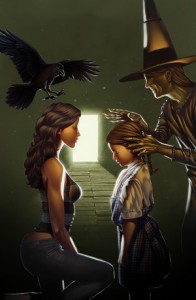 Do you plan to stick with the series?
Do you plan to stick with the series?
Dan: I liked volume 1 but I loved volume 2. I would hold it up against anything I have read in the Fables universe. I love that volume (even with its excessive gun play, Mike!), a story that has a new lead allowing the authors to explore areas outside of the traditional Oz and Wonderland models. I really enjoy that they brought Jack Pumpkinhead and Cheshire Cat back, but this time exploring our world. And any graphical complaints I have about volume 1 do not exist in the follow-up.
Do yourself a favor, friends: read volume 1 so you can jump into volume 2! I have also read the Prelude volume, which features a new original lead character and the very interesting Mr. Raven. At this point, Ben Avery is probably saddened that I have his contact information since I have politely asked (demanded) volume 3. I really want to see where this story, especially the storyline involving the Wizard and Mae, goes from here.
Mike: I do, too. I plan to pick up the Prelude as soon as I can. I’m impressed to hear (but not surprised) that it, too, is both like and unlike all that has gone before. Oz/Wonderland is one of the most creative things I’ve read in comics in some time, and it deserves to be read by any fan of either fantasy land, or smart, strong, character-driven fantasy in general.
Dan: Please, Avery and Heying, give us more!

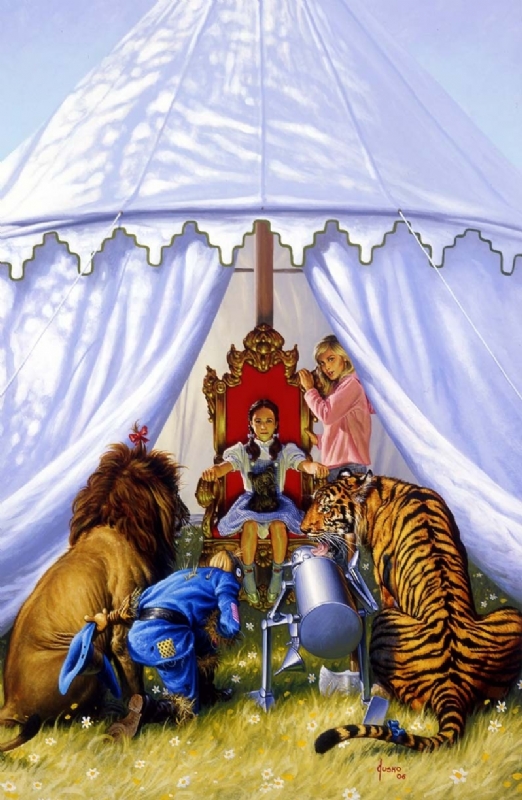
I want to read this!
You definitely should! Good, good stuff.
Sounds really cool!